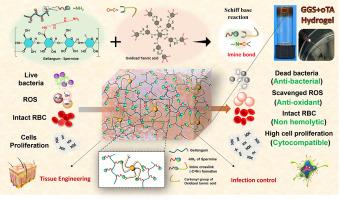Chemically engineered multifunctional hydrogel for potential use in biomedical applications: A report on synthesis, physicochemical characterizations, and in vitro evaluation
IF 9.2
2区 工程技术
Q1 ENERGY & FUELS
引用次数: 0
Abstract
Addressing the limitations of conventional polymeric hydrogels in eradicating bacterial infection and stimulating cell activity within a biological environment presents a significant challenge. However, chemically engineered biopolymers have gained significant attention in designing advanced hydrogel-based platforms due to their flexibility, tunable properties, multiple functionalities, and ability to deliver bioactive agents. In this study, a novel biopolymer conjugate has been synthesized through simple EDC/NHS chemical functionalization methods, where bioactive spermine, a bioamine, was conjugated to the polymeric backbone of gellan gum (GG). Analytical characterization confirmed the successful synthesis of the GG-S conjugate. This conjugate was further engineered into a multifunctional, injectable hydrogel by incorporating oxidized tannic acid (oTA), forming a crosslinked 3D matrix via imine bond formation or Schiff base reaction with superior physicochemical properties. Physicochemical characterization of novel hydrogel shows the desirable injectability profile, microporous morphology, swelling rate, degradation, and drug release profile. In vitro evaluations of hydrogel (GG-S-oTA) exhibit remarkable antibacterial, antioxidant, hemocompatibility, and excellent cytocompatibility, resulting in a twofold increase in cell viability compared to controls. These attributes highlight the potential of the GG–S–oTA hydrogel platform as a multifunctional biomaterial for diverse biomedical applications, effectively addressing challenges related to infection control while also promoting environmental sustainability.

用于生物医学应用的化学工程多功能水凝胶:合成、物理化学表征和体外评价报告
解决传统聚合物水凝胶在消除细菌感染和刺激生物环境中细胞活性方面的局限性是一个重大挑战。然而,化学工程生物聚合物由于其灵活性、可调特性、多种功能和输送生物活性物质的能力,在设计先进的水凝胶基平台方面受到了极大的关注。在这项研究中,通过简单的EDC/NHS化学功能化方法合成了一种新的生物聚合物缀合物,其中生物胺(一种生物胺)与结冷胶(GG)的聚合主链缀合。分析表征证实了GG-S共轭物的成功合成。通过加入氧化单宁酸(oTA),通过亚胺键形成或希夫碱反应形成交联的3D基质,该共轭物进一步被设计成多功能可注射的水凝胶,具有优越的物理化学性质。新型水凝胶的物理化学表征显示了理想的可注射性、微孔形态、膨胀率、降解和药物释放特征。体外评价水凝胶(GG-S-oTA)表现出显著的抗菌、抗氧化、血液相容性和出色的细胞相容性,与对照组相比,细胞活力增加了两倍。这些特性突出了GG-S-oTA水凝胶平台作为多种生物医学应用的多功能生物材料的潜力,有效解决与感染控制相关的挑战,同时促进环境的可持续性。
本文章由计算机程序翻译,如有差异,请以英文原文为准。
求助全文
约1分钟内获得全文
求助全文
来源期刊

Sustainable Materials and Technologies
Energy-Renewable Energy, Sustainability and the Environment
CiteScore
13.40
自引率
4.20%
发文量
158
审稿时长
45 days
期刊介绍:
Sustainable Materials and Technologies (SM&T), an international, cross-disciplinary, fully open access journal published by Elsevier, focuses on original full-length research articles and reviews. It covers applied or fundamental science of nano-, micro-, meso-, and macro-scale aspects of materials and technologies for sustainable development. SM&T gives special attention to contributions that bridge the knowledge gap between materials and system designs.
 求助内容:
求助内容: 应助结果提醒方式:
应助结果提醒方式:


